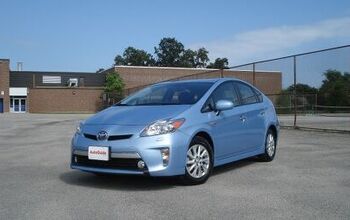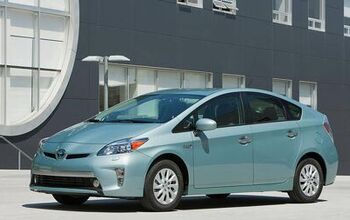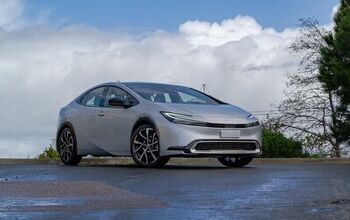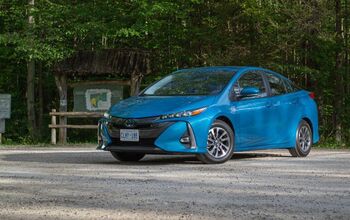2013 Toyota Prius Plug-in Review – Video

Arriving late to the plug-in party and overshadowed by more statistically impressive cars like the Chevrolet Volt, the plug-in Prius hasn’t garnered much attention. That’s likely that reason it hasn’t sold particularly well.
FAST FACTS
| 1. The Prius PHEV is rated at 87 MPGe (miles per gallon equivalent) in EV mode and 49 mpg in regular hybrid mode. |
| 2. Charge time takes 1.5 hours with a quick charger or 3 hours with a conventional household outlet. |
| 3. The plug-in Prius boasts a 15 mile emissions-free range. |
| 4. Pricing starts at $32,000. |
On paper it fails to excite, preferring instead to deliver results in the real world and for that reason it is likely the best green option on the market.
FAMILIAR LOOK, BUT IS IT TOO FAMILIAR?
Perhaps a unique style would have helped set the car apart from its “conventional” hybrid sibling. Instead Toyota used an identical body shape with just a few small tweaks. Those include custom wheels as well as faux-metal door handles and matching trim on the front bumper and rear hatch. Besides that there are blue accented headlights and LED taillights while the obvious give-aways include “plug-in hybrid” badging on the front fenders and an extra “gas” door hiding the electric charge port.
SAME OLD INTERIOR
A more individual interior might have helped the Prius PHEV in the sales department too. Instead, it’s the same-old cabin. Once a talking-point by nature of its originality, after four years on the market in the regular Prius it’s just a lot of eco-styled plastic. Having the gauges located in the center of the dash isn’t just annoying and out of the driver’s line of sight, it’s means the view out front is replaced with, yup, more plastic.
RESEARCH: See the full specs on the Toyota Prius PHEV
Those display screens are looking as modern as a Palm Pilot at CES, though at least their simplicity makes them easy to read and understand, helping you get the most out of your hybrid.
PAYING A PREMIUM FOR PHEV
Comparing the car directly to the standard Prius is next to impossible as it comes with a mish-mash of equipment from the Prius Two trim, as well as a few items from the Prius Three and Four trim levels. The list includes a smart key with keyless access and push button start, a touch-screen display audio with nav and a rear backup camera as well as Toyota’s EnTune system. The touch tracer redundant steering wheel controls that light up look dated
The PHEV also comes standard with heated seats (it’s more efficient to heat your behind than the entire car), though unfortunately the buttons are located underneath the center console and almost on the floor making them nearly impossible to reach.
All said, Toyota prices the car at $32,000 which at a $7,800 premium over the regular Prius sounds excessive. There is, however, a $2,500 tax rebate (based on the size of the car’s battery it’s not as impressive as the $7,500 rebate the Volt qualifies for), brining that price premium to a more realistic $5,300.
WHAT MAKES IT UNIQUE?
With a price that’s certainly divergent from the regular Prius liftback, the changes become more obvious when you examine the technical details and get out on the road.
To say it’s different under the hood, however, would be a misstatement. Pop the painted aluminum and you’ll find the same 1.8-liter 4-cylinder engine and electric motor with an identical total system output of 134 hp. Things only become unique when you examine the battery. For starters, it’s the first use of a lithium-ion unit in a Toyota production car. The regular Prius continues to use a nickel metal hydride pack and while considered outdated, that car still whoops its gasoline-electric rivals with it.
COMPARE: See how the Prius PHEV fares against other plug-ins
What the new battery does is allow for a 15 mile electric range. Nowhere near as impressive as the Volt’s 38 mile claim, the Prius Plug-in also gets an EPA rated 87 MPGe (or mile per gallon equivalent) combined, again falling short of the Volt’s 93 MPGe number. Run out of juice and it’s a different story with the Prius returning 49 mpg in conventional hybrid mode compared to the Volt’s lackluster 37 mpg – which was more like 33 mpg in our testing. In other words, when you’re not plugging it in, it’s much more efficient.
The key is the ability to switch from pure EV mode to hybrid mode at the push of a button. The efficiency of electric cars is the opposite of conventional gas powered machines in that they get better mileage in the city rather than out on the highway. By allowing the driver to choose his or her motivational force the more efficient method can be customized to the type of drive. Turn on EV mode through suburbia to the highway on-ramp. Revert to hybrid mode on the highway, and then back to electric power for the congested city streets.
Of course, get too heavy on the throttle and the gas engine will kick on even in EV mode. Fully electric power can also only be used up until just above 60 mph.
REAL WORLD FUEL ECONOMY
On my own 40 mile one-way commute I managed 63.5 mpg. For those with something as reasonable as 20 miles or less, the claimed 87 MPGe rating is realistic. On short jaunts I even managed almost 100 mpg.
Make trips that are too brief, however, and the opposite can happen, particularly if it’s cold out. In lower temps the Prius Plug-in will override the EV-only mode to run the engine and warm up the system. Unfortunately this takes a few minutes and on a brief 3.2 mile round trip I managed just 35 mpg with the engine revving higher in a warm-up mode.
Charge time for the Prius PHEV is another of the car’s advantages. It takes just 1.5 hours to fill the battery using a quick charger, or 3 hours with a conventional wall socket. Finding 3 hours to plug-in, be it at home or the office, isn’t going to be an issue and not having to pay to install a quick charger is another way the Prius PHEV helps save you money.
Further savings can be achieved by setting the car to charge at off-peak hours. A fancy app does it in the higher-trim $39,250 ‘Advanced’ model, which also includes items like faux leather, a heads-up display system an upgraded audio system, a power driver’s seat, LED headlights and radar cruise control with a pre-collision system. Regardless of the add-ons, it’s hardly a value proposition.
IS IT WORTH IT?
The same can in many ways be said of even the base car, or the Prius in general. Hybrid cars can take years and years to see a return on investment (if ever), saving pennies at the pump in exchange for many thousands more up-front. That said, it’s hard to make a case for the Prius plug-in based strictly on economics, though it certainly makes a better argument than most with a relatively low point of entry.
Often, however, buyers in this segment aren’t looking for the best price, but rather the greenest car and here’s where the Prius loses out – or at least appears to. It doesn’t boast the advances of the Volt, while it also doesn’t boast numbers dramatically higher than the conventional Prius. In fact, the impressiveness of that car could be the biggest single factor holding the PHEV back.
THE VERDICT
Drive with it day-to-day, however, and the advantages of the plug-in model are obvious. Achieving 87 MPGe for right around $30,000 it combines minimal up-front cost and a solid real-world return on investment mixed with a reduced carbon footprint and without the limitations of a pure electric car. While the Prius PHEV, like the conventional Prius, might lack sex appeal, it’s arguably the very best choice for the majority of green car shoppers.
LOVE IT
- A plug-in hybrid for $32,000.
- Amazing real-world fuel economy.
- Fast charge time and no need for a quick-charger
LEAVE IT
- Poor fuel economy on short trips in the cold
- Dull driving experience
- Heated seat buttons on the floor

With AutoGuide from its launch, Colum previously acted as Editor-in-Chief of Modified Luxury & Exotics magazine where he became a certifiable car snob driving supercars like the Koenigsegg CCX and racing down the autobahn in anything over 500 hp. He has won numerous automotive journalism awards including the Best Video Journalism Award in 2014 and 2015 from the Automotive Journalists Association of Canada (AJAC). Colum founded Geared Content Studios, VerticalScope's in-house branded content division and works to find ways to integrate brands organically into content.
More by Colum Wood































Comments
Join the conversation
It should look more unique than the regular Prius I think... that would help sales.